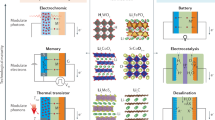Abstract
Ion conduction is of prime importance for solid-state reactions in ionic systems, and for devices such as high-temperature batteries and fuel cells, chemical filters and sensors1,2. Ionic conductivity in solid electrolytes can be improved by dissolving appropriate impurities into the structure or by introducing interfaces that cause the redistribution of ions in the space-charge regions3,4,5,6,7,8,9,10,11. Heterojunctions in two-phase systems should be particularly efficient at improving ionic conduction3,4, and a qualitatively different conductivity behaviour is expected when interface spacing is comparable to or smaller than the width of the space-charge regions in comparatively large crystals12,13,14,15. Here we report the preparation, by molecular-beam epitaxy, of defined heterolayered films composed of CaF2 and BaF2 that exhibit ionic conductivity (parallel to the interfaces) increasing proportionally with interface density—for interfacial spacing greater than 50 nanometres. The results are in excellent agreement with semi-infinite space-charge calculations3, assuming a redistribution of fluoride ions at the interfaces. If the spacing is reduced further, the boundary zones overlap and the predicted mesoscopic size effect3,12 is observed. At this point, the single layers lose their individuality and an artificial ionically conducting material with anomalous transport properties is generated. Our results should lead to fundamental insight into ionic contact processes and to tailored ionic conductors of potential relevance for medium-temperature applications.
This is a preview of subscription content, access via your institution
Access options
Subscribe to this journal
Receive 51 print issues and online access
$199.00 per year
only $3.90 per issue
Buy this article
- Purchase on Springer Link
- Instant access to full article PDF
Prices may be subject to local taxes which are calculated during checkout




Similar content being viewed by others
References
Wagner, C. & Schottky, W. Theorie der geordneten Mischphasen. Z. Phys. Chem. B 11, 163–210 (1930).
Kudo, T. & Fueki, K. Solid State Ionics 1st edn (VCH, Weinheim, 1990).
Maier, J. Ionic conduction in space charge regions. Prog. Solid State Chem. 23, 171–263 (1995).
Maier, J. Space charge regions in solid two phase systems and their conduction contribution - II: contact equilibrium at the interphase of two ionic conductors and the related conductivity effect. Ber. Bunsenges. Phys. Chem. 89, 355–362 (1985).
Maier, J. Defect chemistry and conductivity effects in heterogeneous solid electrolytes. J. Electrochem. Soc. 134, 1524–1535 (1987).
Liang, C. C. Conduction characteristics of the lithium iodide-aluminum oxide solid electrolytes. J. Electrochem. Soc. 120, 1289–1292 (1973).
Maier, J. Space charge regions in solid two phase systems and their conduction contribution - I. conductance enhancement in the system ionic conductor-‘inert’ phase and application on AgCl:Al2O3 and AgCl:SiO2. J. Phys. Chem. Solids 46, 309–320 (1985).
Maier, J., Lauer, U. & Göpel, W. Gas-sensitivity of AgCl interfaces. Solid State Ionics 40/41, 463–467 (1990).
Saito, Y. & Maier, J. Ionic conductivity enhancement of the fluoride conductor CaF2 by grain boundary activation using Lewis acids. J. Electrochem. Soc. 142, 3078–3083 (1995).
Shahi, K. & Wagner, J. B. Fast ion-transport in silver-halide solid-solutions and multiphase systems. Appl. Phys. Lett. 37, 757–759 (1980).
Maier, J. Enhancement of the ionic conductivity in solid-solid-dispersions by surface induced defects. Ber. Bunsenges. Phys. Chem. 88, 1057–1062 (1984).
Maier, J. Space charge regions in solid two phase systems and their conduction contribution - III: defect chemistry and ionic conductivity in thin films. Solid State Ionics 23, 59–67 (1987).
Maier, J. Point-defect thermodynamics and size effects. Solid State Ionics 131, 13–22 (2000).
Lee, J. -S., Adams, S. & Maier, J. Transport and phase transition characteristics in AgI : Al2O3 composite electrolytes - Evidence for a highly conducting 7-layer AgI polytype. J. Electrochem. Soc. 147, 2407–2418 (2000).
Maier, J. Point defect thermodynamics: Macro- vs. nanocrystals. Electrochemistry 68, 395–402 (2000).
Eberl, K., Petroff, P. M. & Demeester, P. (eds) in Proc. NATO Advanced Res. Workshop (Kluwer, Dordrecht, 1995)
Farrow, R. F. C., Sullivan, P. W., Williams, G. M., Jones, G. R. & Cameron, D. C. MBE-grown fluoride films-a new class of epitaxial dielectrics. J. Vac. Sci. Technol. 19, 415–420 (1981).
Bollmann, W. Ionic conductivity of pure and doped BaF2 crystals. Phys. Status Solidi A 18, 313–321 (1973).
Bollmann, W. & Reimann, R. Concentration and mobility of interstitial fluorine ions in CaF2. Phys. Status Solidi A 16, 187–196 (1973).
Schoonman, J. in Fast Ion Transport in Solids (eds Vashishta, P., Mundy, V & Shenoy, V) 631–636 (Elsevier, North-Holland, New York, 1979).
Puin, W., Rodewald, S., Ramlau, R., Heitjans, P. & Maier, J. Local and overall ionic conductivity in nanocrystalline CaF2. Solid State Ionics 131, 159–164 (2000).
Schoonman, J. Nanostructured materials in solid state ionics. Solid State Ionics 135–137, 5–20 (2000).
Tuller, H. L. Ionic conduction in nanocrystalline materials. Solid State Ionics 131, 143–157 (2000).
Acknowledgements
We thank W. Kussmaul for experimental assistance, G. Bilger and H. Kerber for the performance of SIMS and X-ray pole-figure measurements, and W. Dietsche for advice.
Author information
Authors and Affiliations
Rights and permissions
About this article
Cite this article
Sata, N., Eberman, K., Eberl, K. et al. Mesoscopic fast ion conduction in nanometre-scale planar heterostructures. Nature 408, 946–949 (2000). https://doi.org/10.1038/35050047
Received:
Accepted:
Issue Date:
DOI: https://doi.org/10.1038/35050047
This article is cited by
-
An ordered, self-assembled nanocomposite with efficient electronic and ionic transport
Nature Materials (2023)
-
Boosting the interfacial superionic conduction of halide solid electrolytes for all-solid-state batteries
Nature Communications (2023)
-
Self-organized hetero-nanodomains actuating super Li+ conduction in glass ceramics
Nature Communications (2023)
-
Polarization independent silicon on calcium fluoride-based MIR optical modulator
Optical and Quantum Electronics (2023)
-
Bismuth-based metal-organic frameworks derived rod-like nanoreactors for neutral aqueous battery-type anode
Science China Materials (2023)
Comments
By submitting a comment you agree to abide by our Terms and Community Guidelines. If you find something abusive or that does not comply with our terms or guidelines please flag it as inappropriate.



